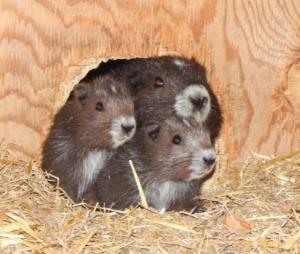In March 2015, CBSG led a conservation planning workshop for Vancouver Island marmots to help guide future recovery planning for this Critically Endangered species in Canada. The resulting One Plan approach conservation effort, which combines fully integrated in situ and ex situ populations along with collaboration among government, industry, academia, zoos, and an NGO, has averted species extinction and is progressing the species toward recovery.
The report from the workshop and the recommendations within it are considered advisory to the Vancouver Island Marmot Recovery Team to help guide actions thought to be beneficial to the long-term survival of the Vancouver Island marmot in Canada. Recommendations from the workshop will be forwarded to the Recovery Team for consideration at their next assessment of the status of the species.
The following text is a press release from Calgary Zoo about recent developments in their conservation efforts for Vancouver Island marmots, including the report from the CBSG-led planning workshop, which is being used to guide recovery efforts.
Growing Pups and Populations
Vancouver Island Marmots Mark Conservation Achievements
 Calgary, AB – The Calgary Zoo is pleased to report that 14 healthy Vancouver Island marmot pups were born during the 2015 breeding season. The pups are very valuable as the species is listed as endangered and considered one of the rarest mammals in the world.
Calgary, AB – The Calgary Zoo is pleased to report that 14 healthy Vancouver Island marmot pups were born during the 2015 breeding season. The pups are very valuable as the species is listed as endangered and considered one of the rarest mammals in the world.
“The Calgary Zoo currently holds two thirds of the captive population of marmots and this has been an excellent year for us with a healthy population of new pups that will bolster the wild population,” says Dr. Doug Whiteside, Senior Veterinarian, Calgary Zoo and Vancouver Island Marmot Recovery Team member. “Being involved in the captive breeding program since 1998, we have been fortunate to have played a key role in the reproductive and health-based research on the species in addition to the behavioural research carried out as part of our Husky Energy Endangered Species Program.”
The pups were comprised of four females and 10 males from four litters. The Animal Care team at the zoo’s Wildlife Conservation Centre had some fun with the naming of the pups, keeping the Star Wars movie release in mind. Luke and Leia, Han Solo, Jabba, Yoda were some of the names chosen. 13 of the 14 pups are tentatively scheduled for release in the wild next year.
The strategy for increasing wild marmot populations involves increasing colony numbers through translocations and augmentation, while critically evaluating the success of reintroduction based on the ability to establish and maintain colonies through survival and reproduction.
Published last week are primary findings out of an important Population and Habitat Viability Assessment (PHVA) workshop held in the spring by the Calgary Zoo, Vancouver Island Marmot Recovery Foundation and facilitated by the IUCN SSC Conservation Breeding Specialist Group in partnership with the IUCN SSC Reintroduction Specialist Group.
After reviewing all the evidence of the recovery to date, the group recognized tremendous improvements in the recovery of this species. Formerly one of the most endangered mammals in North America, the best estimate is that there are now 300 marmots in the wild, an increase from a mere 30 at one time. This is the eighteenth year of the captive breeding program and sixteenth year of successful breeding, with 46 individuals currently in the entire captive population.
“Globally this is one of the most rapid reintroduction-based population improvements of a critically endangered mammal in the wild,” says Dr. Axel Moehrenschlager, Calgary Zoo Director of Conservation & Science, IUCN SSC Chair, Reintroduction Specialist Group.
A group of 40 experts committed to the following goals which are critical for the future of this species.
- Maximize existing biological information as a foundation that can guide science-based wildlife management and financial investment.
- Accurately determine the size, trend and drivers of the wild population and understand the relationship among landscape changes, human presence and predator/prey relationships.
- Ensure that the captive population is of a sufficient size and genetic diversity to support the growth of wild marmot populations and to act as a safe-guard for wild populations.
- Recognize that a population of this size will always require some level of monitoring.
- Achieve financial stability, without which all recovery actions are threatened and the sustainability of the species may be compromised.
The final PHVA report can be accessed here: http://www.cbsg.org/content/vancouver-island-marmot-phva-report-2015.
Partners involved in the captive breeding program include: The Marmot Recovery Foundation, Tony Barrett Mount Washington Marmot Recovery Centre, The Province of British Columbia, the Fish & Wildlife Compensation Program, Toronto Zoo and the Calgary Zoo.
See: www.calgaryzoo.com


